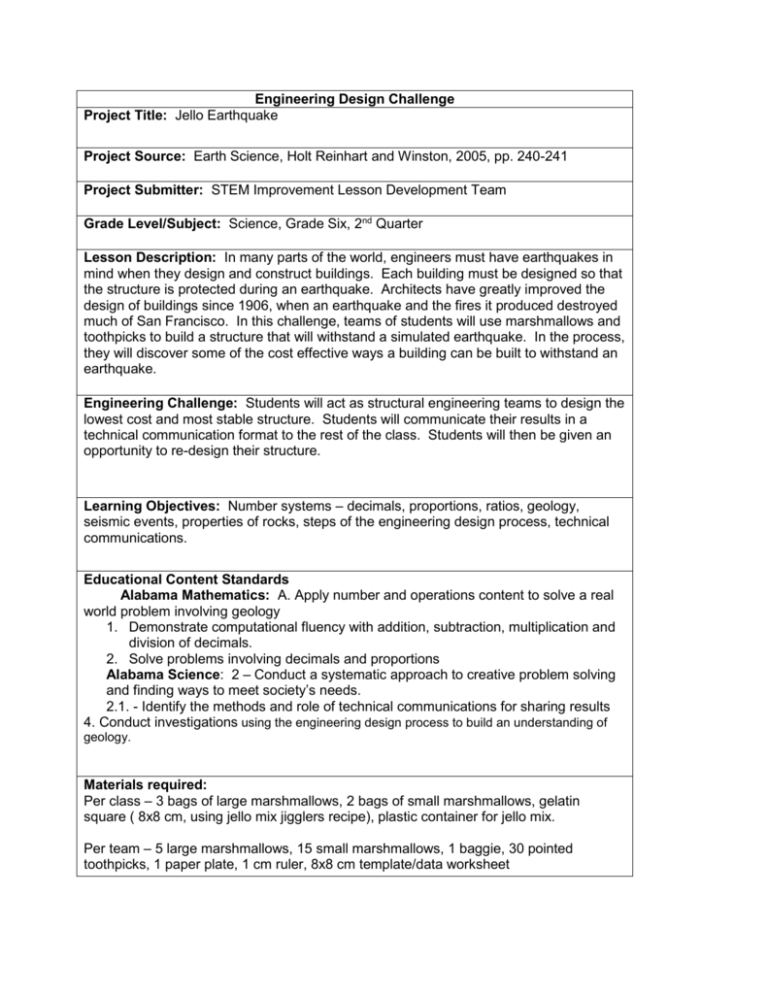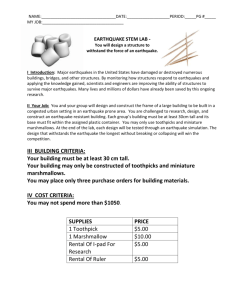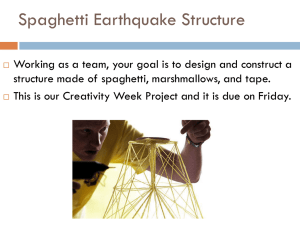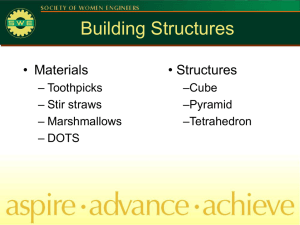Jello Earthquake - Pcmac.org
advertisement

Engineering Design Challenge Project Title: Jello Earthquake Project Source: Earth Science, Holt Reinhart and Winston, 2005, pp. 240-241 Project Submitter: STEM Improvement Lesson Development Team Grade Level/Subject: Science, Grade Six, 2nd Quarter Lesson Description: In many parts of the world, engineers must have earthquakes in mind when they design and construct buildings. Each building must be designed so that the structure is protected during an earthquake. Architects have greatly improved the design of buildings since 1906, when an earthquake and the fires it produced destroyed much of San Francisco. In this challenge, teams of students will use marshmallows and toothpicks to build a structure that will withstand a simulated earthquake. In the process, they will discover some of the cost effective ways a building can be built to withstand an earthquake. Engineering Challenge: Students will act as structural engineering teams to design the lowest cost and most stable structure. Students will communicate their results in a technical communication format to the rest of the class. Students will then be given an opportunity to re-design their structure. Learning Objectives: Number systems – decimals, proportions, ratios, geology, seismic events, properties of rocks, steps of the engineering design process, technical communications. Educational Content Standards Alabama Mathematics: A. Apply number and operations content to solve a real world problem involving geology 1. Demonstrate computational fluency with addition, subtraction, multiplication and division of decimals. 2. Solve problems involving decimals and proportions Alabama Science: 2 – Conduct a systematic approach to creative problem solving and finding ways to meet society’s needs. 2.1. - Identify the methods and role of technical communications for sharing results 4. Conduct investigations using the engineering design process to build an understanding of geology. Materials required: Per class – 3 bags of large marshmallows, 2 bags of small marshmallows, gelatin square ( 8x8 cm, using jello mix jigglers recipe), plastic container for jello mix. Per team – 5 large marshmallows, 15 small marshmallows, 1 baggie, 30 pointed toothpicks, 1 paper plate, 1 cm ruler, 8x8 cm template/data worksheet Jello Earthquake 6th Grade Science, 2nd Quarter Objective: Build a prototype of a structure that can withstand a simulated earthquake. Recommendations before starting: 1. Day before, introduce to class-“Tomorrow we will…; You will be the following groups…; Tonight I want you to think about how you would design your structure.” Use as an exit slip/wrap up activity. 2. Day before, prepare Jello jiggler recipe *3. Open marshmallows a day or two before being used; this will make them stiff and not as sticky to work with. 4. Have items to be used already grouped. 5. Make copies of Student Handout – Jello Earthquake Worksheet (copy on both sides) Day 1 Engage: **Use PowerPoint/SMART that has bell ringer, essential question, video link, ect.** Define the problem: How can you design a low cost structure, with at least two levels, that can withstand a simulated earthquake? The following is in the introductory PowerPoint/SMART. In many parts of the world, engineers must have earthquakes in mind when they design and construct buildings. Each building must be designed so that the structure is protected during an earthquake. Architects have greatly improved the design of buildings since 1906, when an earthquake and the fires it produced destroyed much of San Francisco. In this challenge, you will use marshmallows and toothpicks to build a structure that can withstand a simulated earthquake. In the process you will discover some of the cost effective ways a building can be built to withstand an earthquake. Research the Problem: Video: “Earthquake-Proof Buildings” segment of the Haiti’s Killer Quake: Why It Happened; video must be stopped at 5:25 or you will give away a very important design detail that you want the students to discover on their own. The end of the video will be watched on DAY 2. Ground Rules for Structure: (included in PowerPoint/SMART) Constraints 1. at least two stories 2. base no larger than 8x8 cm 3. teams of 3 4. the inside of structure has to be open 5. no underground supports 6. extra materials may be purchased for a 10% up charge from the lumber company Explore: Develop Solutions 1. Each group has brainstormed and sketched their design on their worksheet (in the 8x8 cm square). Choose the Best Solution 2. Give each group of 3 a baggie with 5 large marshmallows, 15 small marshmallows, and 30 toothpicks. Extra materials may be purchased for a 10% up charge. 3. Each group will use given materials to construct their prototype structure. There is a price for materials and they must keep up with materials used to calculate total “cost” of prototype. Calculations will be made on DAY 2. Create a Prototype 4. Give each group 15 minutes to construct their structure. 5. Each group should measure and record the height of their prototype structure on their worksheet. Test 6. Test each structure on the Jello mold that has been placed on a paper plate. The teacher is the tester and will shake the mold for 5 seconds. Explain: Communicate 7. Sketch your final prototype on the back of your worksheet. The students will present their design as it is tested and explain why they built it as is. 8. Record results of prototype’s survival (did it make it?). Chart included in PowerPoint/SMART. 9. Prototypes DO NOT have to be kept. Clean-up includes throwing all structures away. Day 2 Research 1. Take data collected in yesterday’s class and calculate the cost of the team’s structure. “Make sure you calculate the 10% up charge for extra materials ordered.” (Calculators might be a good idea when calculating cost.) 2. Add total cost to chart started yesterday. 3. Watch the “Earthquake-Proof Buildings” video segment. Extend: Re-design 4. After seeing everyone’s designs yesterday and the video today, “How would you redesign your structure? Re-design the earthquake proof prototype structure. Sketch your new structure in the space provided on the back of your worksheet. Re-calculate the cost of your re-designed structure. Note: Students will not build their re-designed structure, just sketch it. 5. Students will present re-design of their earthquake proof structure. Have them start preparing for their presentations. Day 3 Communicate Students will use data collected on DAY 1 and DAY 2 to create some method of communicating the technical detail of their design. This could be a line graph, a poster, a PowerPoint, etc. Review the Engineering Design Process (EDP). Display the EDP poster and refer to is as students discuss what they did for each of the steps in the process. Evaluate: TSW will be evaluated on constructing a prototype structure to test; calculating the cost of their prototype; and explaining why they chose the re-design they did. Name ___________________________ Class ________ Date ____________ Materials Large marshmallows Small marshmallows Toothpicks Price $329.78 $85.23 $37.64 Height of structure (in cm) _________________ Total cost of structure _______________ Did your structure survive? Yes No Number of Items







